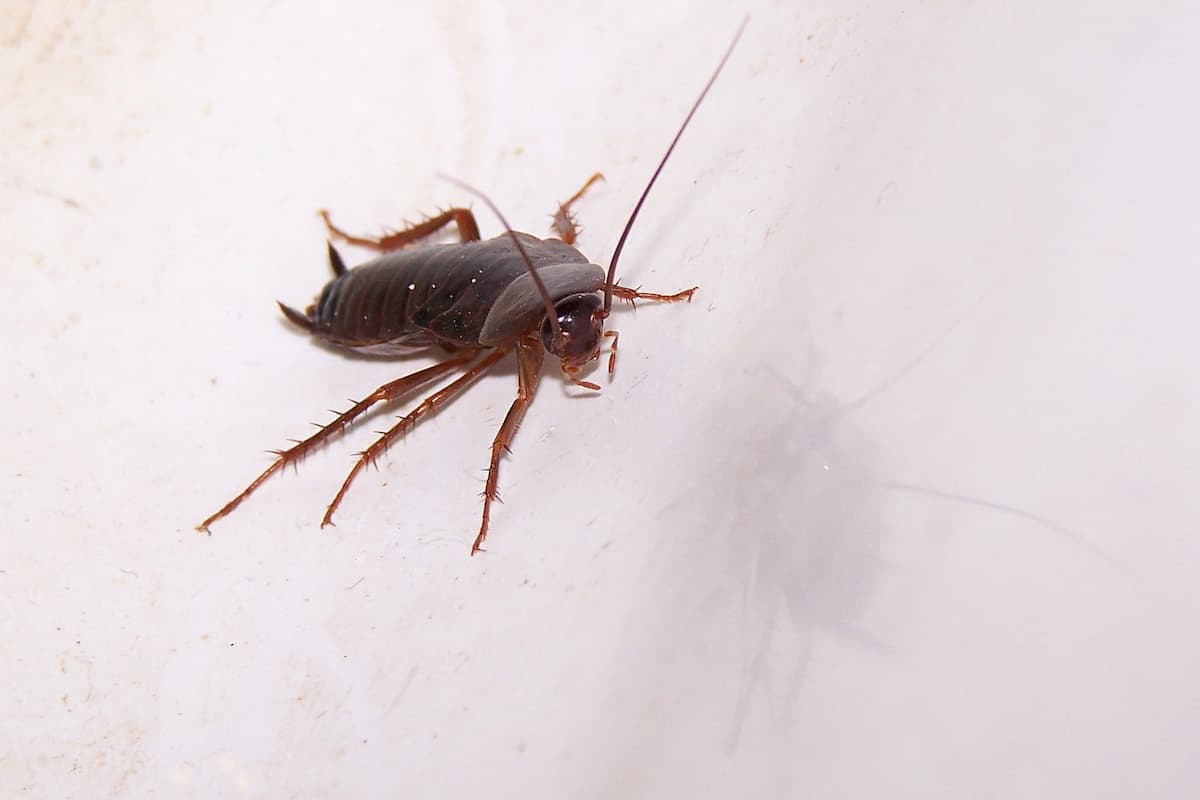How To Get Roaches To Come Out Of Hiding? (3 Ways)
Cockroaches are masters at hiding. The little beasts can crawl into the tiniest of crevices thanks to their flexible exoskeleton and nimble legs.
Such adaptations make eradication harder, and to get rid of cockroaches, you must give them a reason to come out of their nest.
Luckily, there are several ways to get roaches out of hiding. The primary methods are glue traps and bait stations. You can also use DIY strategies like jar traps and duct tape traps.
Whichever way you choose, clean traps often, as dead cockroaches can attract their live friends, making an infestation worse.
3 Ways to Lure Cockroaches Out of Hiding

To increase your chances of eliminating a roach infestation, you must use the cockroaches’ biological processes to your advantage, namely their need for food and their nocturnal nature.
There are three main ways to lure roaches out of hiding with food: sticky traps, bait traps, or a combination of food and traps.
While roaches can go almost a month without food, they’ll gobble up almost anything you put in front of them.
Moreover, since they like hiding in the dark, you must let them be.
If you’re constantly turning on the lights to check the traps, they may avoid the area altogether and find a more strategic way to get the sustenance they need.
They always come out at night, and if you’re clever with your traps, you’ll see decent results a day or two later.
1. Glue or Sticky Traps
Sticky traps have an adhesive surface that catches roaches when they walk over them.
Also known as roach motels, they have artificial pheromones that trick the insects into believing food or breeding mates are within the area.
A glue trap’s effectiveness depends on the chemical’s strength and the roach’s size.
Small roaches are easy to capture as they occupy less surface area. Larger cockroaches might give you a bit of trouble as they can free themselves if given time.
While your trap is most effective when the creatures roam around at night, if one gets caught, it has several hours to try and free itself before you wake up.
Roaches are also annoyingly intelligent. If they see their mates stuck to a weird-looking surface, they might avoid it and find food elsewhere.
You’ll have to do your research and buy the right trap to ensure it’s as effective as possible.
2. Poisoned Bait Stations
Because of how they work, bait traps have a better chance of clearing an infestation than glue traps.
Bait stations contain poisoned ‘food’ that kills the cockroach once ingested. They are more effective than glue traps as they allow the contaminated roach to return to its nest.
Either the poisoned roach will share the food with others, or when it dies, the other cockroaches will eat it and follow suit.
The primary limitation is that bait traps can take four to eight weeks to clear a colony of roaches.
You must also reapply the bait or replace the traps to ensure there’s enough food to eliminate the entire nest.
3. Food Lures
Whether you use a sticky trap or a bait station, you can combine them with real food to entice the insects even more.
The synthetic chemicals in the traps are enough to attract the creatures, but they may not attract them quickly enough.
Placing a piece of bread on the glue trap or adding soft baby food as part of your bait station helps speed up the process.
Though roaches eat almost anything, they prefer starchy, sweet, or greasy foods.
They also like meats as they’re high in protein.
Baby food has a soft texture and reduces the work needed by the insect to digest it.
Pick food that falls into any of these categories and pair it with your traps for more effective extermination.
DIY Alternatives to Commercial Lures
Whether you’re not a fan of commercial traps or simply can’t afford them, there are other ways to ensure roaches come out of hiding.
These methods don’t use chemicals, so they’re a big plus if you have pets or kids.
They also have downsides but can be just as effective as store-bought methods.
1. Peanut Butter and Duct Tape
A peanut butter and duct tape trap is a DIY glue trap.
The duct tape acts as the adhesive that captures the roach, and the peanut butter is the bait that attracts it.
Peanut butter is the preferred bait because it contains the fat, sugar, and protein the insects like. It also has a strong smell, luring the roach directly into the trap.
To set it up, take a piece of duct tape and put the adhesive side up.
Put a small amount of peanut butter in the center (don’t cover the entire tape), and voila! Your sticky trap is done.
Like the glue traps from stores, you must change them regularly.
2. Jar Traps
To make a jar trap, fill a jar with beer or a similar sweet or strong-smelling liquid that can attract cockroaches.
The trap works by luring the roach into the liquid, where you’ll capture and dispose of it.
Since roaches don’t drown easily, line the inner edges with petroleum jelly (or similar products) to prevent the insect from escaping.
To guide the roach inside the trap, use a small piece of wood or a ruler and place it against the jar.
You can also try just using a half-full beer bottle. Beer is almost irresistible to roaches, and the shape of the neck helps trap them inside, where they eventually drown.
Jar traps are more technical than duct tape traps but aren’t as hands-on, so it’s all down to what you prefer.
3. Baking Soda and Sugar
The mixture of sugar and baking soda is a DIY poisonous bait trap.
Cockroaches love sugar and will gravitate towards it whenever they can find it.
When roaches consume baking soda and then drink water, it creates gas inside the gut, eventually killing them.
You have to make sure you don’t use too much baking soda; otherwise, it will actually repel the roaches as they don’t like the smell or taste.
For the best results, equal parts (1-to-1) of baking soda and sugar (powdered is probably best) and sprinkle it in corners, along cracks, and where you’ve seen roaches in the past.
Use a new package of baking soda, as the old product may have lost some potency.
To amplify the effect, put some water nearby, as the water acts as the catalyst for the reaction.
Like commercial bait stations, ensure to re-up DIY traps regularly.
4. Borax and Sugar
Borax is a laundry booster that is also an effective insecticide.
Like baking soda, if you mix borax with sugar, cockroaches will eat it.
Within three days, the borax will dehydrate them, and they will die.
The borax/sugar mix is slightly better than the baking soda mix as it doesn’t need water to work.
In fact, you shouldn’t sprinkle a borax/sugar mix anywhere near water sources as it may impact its efficacy.
Like every other trap, you’ll have to continue to use it until all the roaches are gone.
Where Do Roaches Hide During the Day?

It’s one thing to know how to lure out cockroaches – it’s another to know where to put the traps.
Roaches stay in hiding for most of the day – it’s a survival mechanism to avoid predators.
That means taking the bait to them and hoping they walk into it at nighttime.
The insects will shelter in the darkest spots in your house.
In the kitchen, that’s under large appliances like the fridge and stove, and inside smaller ones like the toaster or microwave. It’s also inside your kitchen cabinets and around under-sink drain pipes.
In bathrooms, that’s around tubs, sinks, and drains.
If you see roaches elsewhere in your home, you can place the traps inside or around closets and dressers in bedrooms.
Other areas in the house include next to furniture, beside wall cracks (ensure to seal them up after the extermination), and around boxes or trash cans.
Some traps are more effective in specific areas of the house, so do a little research and see what might work best in each room.
Conclusion
Cockroaches are pesky creatures, and eradicating them requires getting them out of their dens.
Spraying insecticide into your wall cracks is unlikely to do much as some might avoid the poison and live to reproduce another day.
You also don’t want to spray your appliances for safety and/or hygienic reasons.
Bait stations and sticky traps give you a higher chance of success, while DIY methods like jar traps and duct tape lures work just as well.
However, lures are time-consuming and can’t match the reproduction rate of an infestation.
So, if you’re dealing with a full-blown invasion, bite the bullet and call an exterminator.
